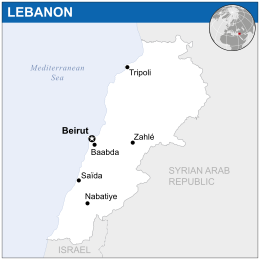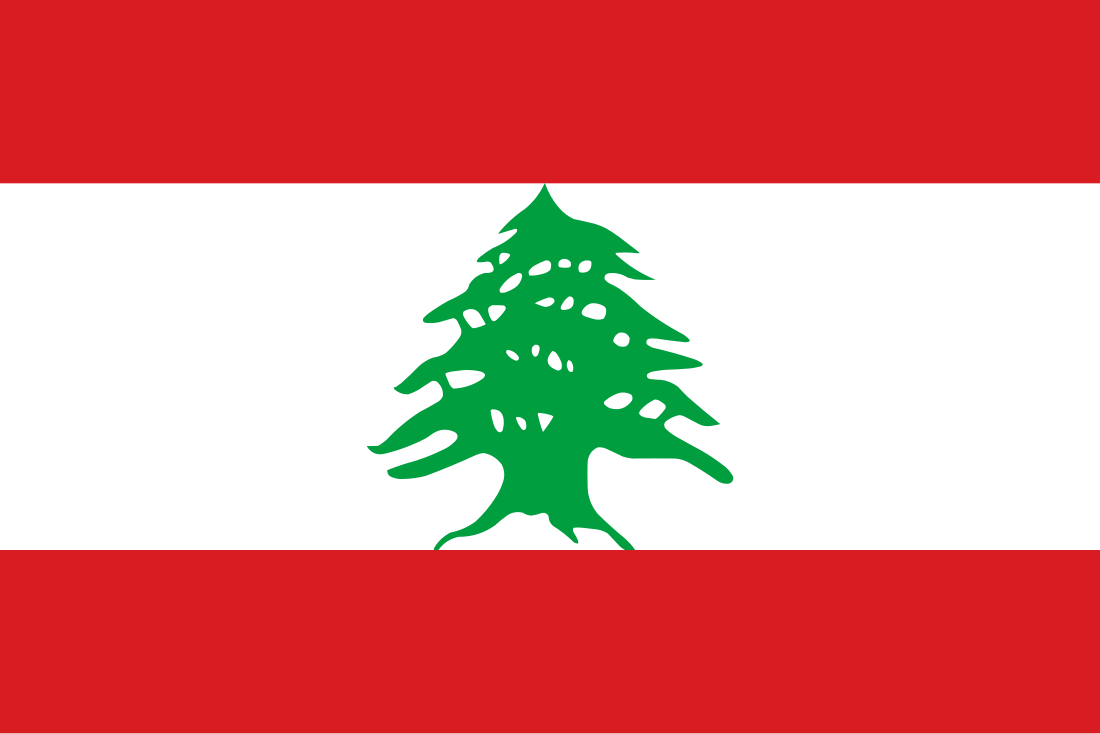Lebanon
sovereign state in Near East From Wikipedia, the free encyclopedia
Lebanon is a country in the Middle East, in Western Asia, next to the Mediterranean Sea. It has borders with Israel to the south and Syria to the east and north. It also shares a maritime border with Cyprus to the northwest, away from the country's short distance.
Republic of Lebanon | |
|---|---|
| Anthem: كلّنا للوطن (Arabic) Koullouna lilouataan lil oula lil alam English: All of us! For our Country! | |
 Location of Lebanon (in green) | |
 | |
| Capital and largest city | Beirut 33°54′N 35°32′E |
| Official languages | Arabic[nb 1] |
| Recognised languages | |
| Local vernacular | Lebanese Arabic |
| Ethnic groups | |
| Religion (Estimated[nb 3]) |
|
| Demonym(s) | Lebanese |
| Government | Unitary confessionalist parliamentary republic[7] |
| Joseph Aoun | |
| Najib Mikati | |
• Speaker of the Parliament | Nabih Berri |
| Legislature | Parliament |
| Establishment | |
• Greater Lebanon | 1 September 1920 |
• Constitution | 23 May 1926 |
• Independence declared | 22 November 1943 |
• French mandate ended | 24 October 1945 |
• Withdrawal of French forces | 17 April 1946 |
• Israeli troops withdrawn | 24 May 2000 |
• Syrian troops withdrawn | 30 April 2005 |
| Area | |
• Total | 10,452 km2 (4,036 sq mi) (161st) |
• Water (%) | 1.8 |
| Population | |
• 2021 estimate | 5,592,631[8][9] (109th) |
• Density | 560/km2 (1,450.4/sq mi) (21st) |
| GDP (PPP) | 2020 estimate |
• Total | $91 billion[10] |
• Per capita | $11,562[10] (66th) |
| GDP (nominal) | 2020 estimate |
• Total | $18 billion[10] (82nd) |
• Per capita | $2,745[10] |
| Gini (2011) | 31.8[11] medium |
| HDI (2019) | 0.744[12] high · 92nd |
| Currency | Lebanese pound (LBP) |
| Time zone | UTC+2 (EET) |
| UTC+3 (EEST) | |
| Driving side | right[13] |
| Calling code | +961[14] |
| ISO 3166 code | LB |
| Internet TLD | .lb |
History & Data
Lebanon was named Phoenicia under the Roman Empire. Some of the biggest temples in Antiquity were there at Heliopolis. In the 7th century Arabs conquered Phoenicia and imposed their religion Islam. But many areas in the mountains remained Christian as the "Maronites". However, the Christians who remained in the mountains became Arabized and started identifying themselves as "Arab Christians".
Lebanon has been independent since 22 November 1943. Its capital city is Beirut.
Lebanon has two chains of mountains. It has a long coastline. The area of Lebanon is 10,452 square kilometers (4,036 square miles).
The Cedar tree is the national symbol of Lebanon because many of them grow in the Lebanon Mountains.
Population of Lebanon
Around 5.2 million people live in Lebanon.[15]
Around 14 million Lebanese people live outside Lebanon. [16]
The people of Lebanon
About 68% of Lebanese people are Muslim and 32% are Christian.[15]
The official language of Lebanon is Arabic and it is the most common language.[17] French, English, and Armenian are also common languages.
Governorates and districts
Lebanon is divided into six governorates. These are divided into 25 districts.[18] The districts are also divided into several municipalities. The governorates and their districts are listed below:
- Beirut Governorate
- The Beirut Governorate is not divided into districts and is limited to the city of Beirut
- Nabatieh Governorate (Jabal Amel)
- Bint Jbeil
- Hasbaya
- Marjeyoun
- Nabatieh
- Beqaa Governorate
- Baalbek
- Hermel
- Rashaya
- Western Beqaa (al-Beqaa al-Gharbi)
- Zahle
- North Governorate (al-Shamal)
- Akkar
- Batroun
- Bsharri
- Koura
- Miniyeh-Danniyeh
- Tripoli
- Zgharta
- Mount Lebanon Governorate (Jabal Lubnan)
- South Governorate (al-Janoub)
- Jezzine
- Sidon (Saida)
- Tyre (Sur)

Related pages
Notes
- Article 11 of the Constitution of Lebanon states: "Arabic is the official national language. A law shall determine the cases in which the French language can be used." See: French language in Lebanon
- Note: Many Lebanese Christians do not identify as "Arab" but rather as descendants of the ancient Canaanites and prefer to be called "Phoenician".
- Because the relative sizes of different religions and religious sects remains a sensitive issue, a national census has not been conducted since 1932. There are 18 state-recognized religious sects – four Muslim, 12 Christian, one Druze, and one Jewish
- Note: Most Druze do not identify as Muslim, but Druze are classified by the Lebanese government as one of the five Muslim communities in Lebanon (Sunni, Shia, Druze, Alawi, and Ismaili).
References
Wikiwand - on
Seamless Wikipedia browsing. On steroids.


